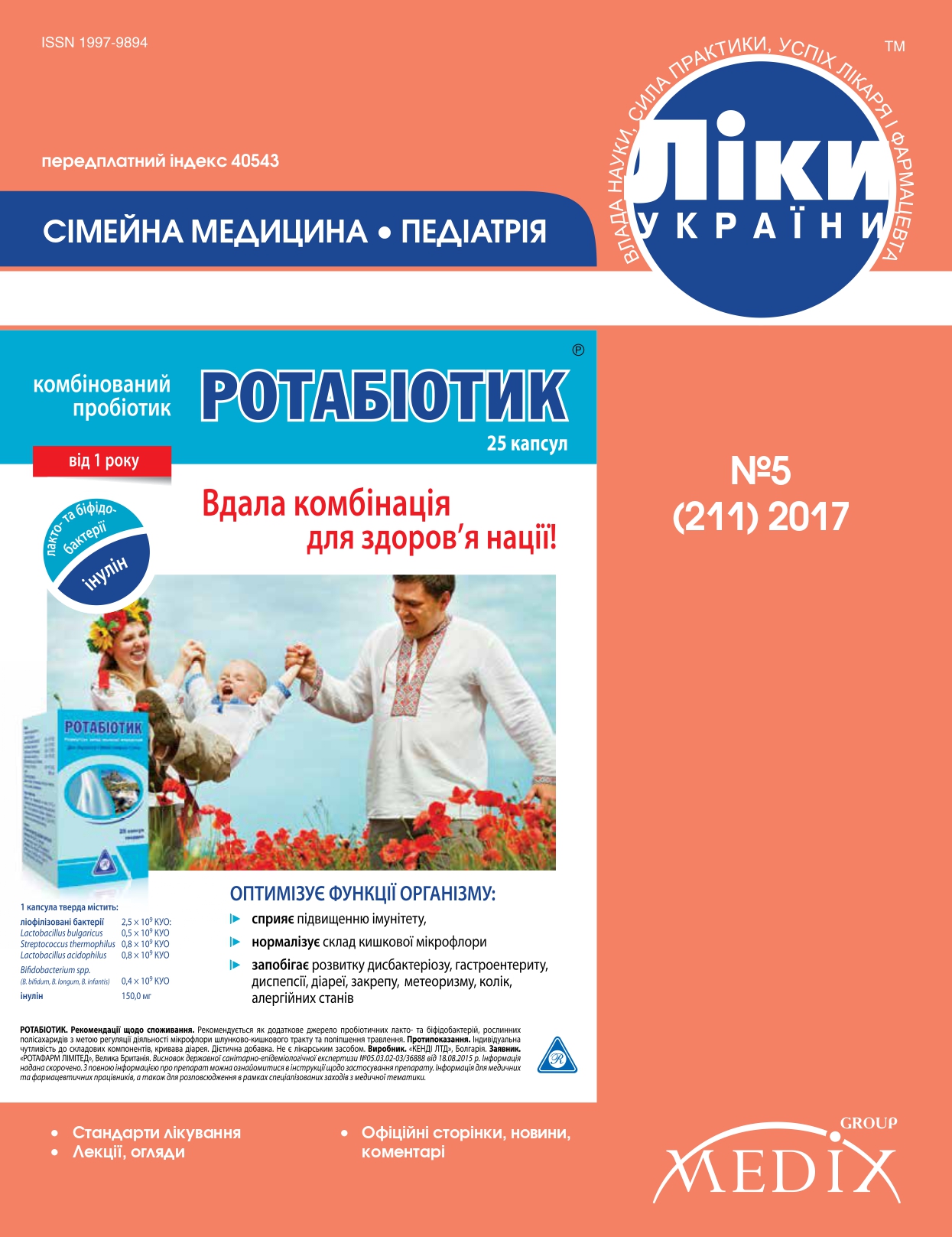Випадок ідіопатичного гіпереозинофільного синдрому у дитини: труднощі диференціальної діагностики
DOI:
https://doi.org/10.37987/1997-9894.2017.5(211).222057Анотація
У статті висвітлено патогенез еозинофільного синдрому, відмінності первинної та вторинної еозинофілії, основні причини, в тому числі генетичні мутації, що асоціюються з гіпереозинофілією. Класичним клінічним проявом гіпереозинофільного синдрому є ідіопатичний гіпереозинофільний синдром (ГЕС). На прикладі ГЕС у дитини розглянуто основні синдроми і ускладнення, зумовлені еозинофілією, питання диференціальної діагностики та основні напрями лікування. У висновку наголошується, що ГЕС є мультидисциплінарною проблемою і може зацікавити лікарів багатьох спеціальностей.
Посилання
Bain B.J., Ahmad S. Should myeloid and lymphoid neoplasms with PCM1-JAK2 and other rearrangements of JAK2 be recognized as specific entities? // British Journal of Haematology. – 2014. – Vol. 166. – P. 809–817.
Bain B.J., Gilliland D.G., Vardiman J.W., Horny H.-P. Myeloid and lymphoid neoplasmswith eosinophilia and abnormalities of PDFRA, PDGFRB or FGFR. In: World Health Organization Classification of Tumours of Haematopoietic and Lymphoid Tissue / Eds. by S.H. Swerdlow, E. Campo, N.L. Harris, E.S. Jaffe, S.A. Pileri et al. – Lyon: IARC Press, 2008. – P. 68–73.
Brito-Babapulla F. The eosinophilias, including the idiopathic hypereosinophilic syndrome // Br. J. Haematol. – 2003. – Vol. 121. – Р. 203–223.
Butterfield J.H. Interferon treatment for hypereosinophilic syndromes and systemic mastocytosis // Acta Haematologica. – 2005. – Vol. 114. – P. 26–40.
Chusid M.J., Dale D.C., West B.C. et al. The hypereosinophilic syndrome: analysis of fourteen cases with review of the literature // Medicine (Baltimore). – 1975. – Vol. 54, №1. – Р. 1–27.
Fozing T., Zouri N., Tost A., Breit R. et al. Management of a patient with eosinophilic myocarditis and normal peripheral eosinophil count: case report and literature review // Circulation: Heart Failure. – 2014. – Vol. 7. – P. 692–694.
Hardy W.R., Anderson R.E. The hypereosinophilic syndromes // Ann. Intern. Med. – Jun 1968. – Vol. 68,№6. – Р. 1220–1229.
Hosoki K., Nagao M., Iguchi K., Ihara T. et al. An 8-year-old boywith hypereosinophilic syndrome // International Archives of Allergy and Immunology. – 2011. – Vol. 155. – P. 117–122.
Klion A.D., Bochner B.S., Gleich G.J. et al. Approaches to the treatment of hypereosinophilic syndromes: a workshop summary report // J. Allergy Clin. Immunol. – 2006. – Vol. 117. – P. 1292.
Lefebvre C., Bletry O., Degoulet P., Guillevin L. et al. Prognostic factors of hypereosinophilic syndrome. Study of 40 cases // Annales de Medecine Interne (Paris). – 1989. – Vol. 140. – P. 253–257.
Liapis H., Ho A.K., Brown D., Mindel G., Gleich G. Thrombotic microangiopathy associated with the hypereosinophilic syndrome // Kidney International. – 2005. – Vol. 67. – P. 1806–1811.
Manual of pediatric hematology and oncology. – Elsevier Inc., 2005. – P. 235–241.
Nand R., Bryke C., Kroft S.H., Divgi A. et al. Myeloproliferative disorder with eosinophilia and ETV6-ABL gene rearrangement: efficacy of second-generation tyrosine kinase inhibitors // Leukemia Research. – 2009. – Vol. 33. – P. 1144–1146.
Ogbogu P.U., Bochner B.S., Butterfield J.H., Gleich G.J. et al. Hypereosinophilic syndrome: a multicenter, retrospective analysis of clinical characteristics and response to therapy // The Journal of Allergy and Clinical Immunology. – 2009. – Vol. 124. – e1313.
Ommen S.R., Seward J.B., TajikA.J. Clinical and echocardiographic features of hypereosinophilic syndromes //American Journal of Cardiology.–2000.–Vol. 86.–P. 110–113.
Pineton de Chambrun, M., Charron, P., VauthierBrouzes, D., Cluzel, P. et al. Reversible severe eosinophilic endomyocardial fibrosis during pregnancy: a case report // Medicine (Baltimore). – 2015. – Vol. 94. – e1307.
Plotz S.G., Simon H.U., Darsow U., Simon D. et al. Use of an anti-interleukin-5 antibody in the hypereosinophilic syndrome with eosinophilic dermatitis // New England Journal of Medicine. – 2003. – Vol. 349. – P. 2334–2339.
Roufosse F., Weller P.F. Practical approach to the patient with hypereosinophilia // J. Allergy Clin. Immunol. – 2010. – Vol. 126. – P. 39.
Seifert M., Gerth M. et al. Eosinophilia – a challenging differential diagnosis // Med. Klin. (Munich). – 2008. – Vol. 10 (9). – P. 591–597.
Simon H.U., Rothenberg M.E., Bochner B.S. et al. Refining the definition of hypereosinophilic syndrome // J. Allergy Clin. Immunol. – 2010. – Vol. 126. – P. 45.
Tefferi A. Blood eosinophilia: a new paradigm in disease classification, diagnosis, and treatment // Mayo Clin. Proc. – 2005. – Vol. 80. – P. 75.
Valent P., Klion A.D., RosenwasserL.J. et al. ICON: Eosinophil Disorders // World Allergy Organ J. – 2012. – Vol. 5. – P. 174.
Walz C., Erben P., Ritter M., Bloor A. et al. Response of ETV6-FLT3-positive myeloid/ lymphoid neoplasm with eosinophilia to inhibitors of FMS-like tyrosine kinase 3 //. Blood. – 2011. – Vol. 118. – P. 2239–2242.
Weller P.F., Bubley G.J. The idiopathic hypereosinophilic syndrome // Blood. – 1994. – Vol. 83. – P. 2759–2779.


